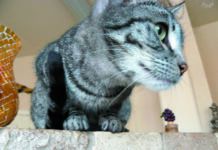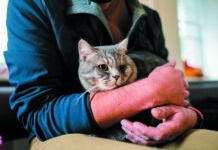Myth: My cat is just naturally lazy. It’s the breed.
Truth: There is no question that there are “fast cats” and “slow cats,” just as some people naturally prefer a sprint to a leisurely park stroll. In the animal world Olympics, cats are sprinters, not marathoners. There’s a natural tendency to assume that just because your cat doesn’t move much, he doesn’t like to move at all.
If your cat is seriously overweight, he may have become less active to compensate for his extra pounds. He may even be unable to jump, and both his heart and his lungs are working overtime. He may not be lazy so much as suffering under the strain.
If this isn’t the case, think about this: have you been training your cat to be lazy? Have you been sending her signals that suggest that it’s better to stay put and get fed than to run around and work for her supper? While the history of cat training is a lot shorter than that of dog training, it exists. The growth of both cat agility and clicker training for cats (covered later on in this book) prove that cats not only can be trained to be active—they actually come to crave it.
Even if you don’t want to have your cat jump through hoops (though you could!) you have a lot more influence over your cat’s activity level than you realize. Pick up your cat’s favorite toy, or, even better, a little dry kibble, and tempt your cat to follow you. Then skip down the hallway. Chances are very good that your “lazy” cat will follow you wherever yougo. It may also be that your home is not set up to be cat exercise friendly. Some cats don’t liek to move around until night time. Some cats adore scaling heights, and leaping from point to point. Making some simple adjustments in your home, such as installing a cat tree, or providing a perch on a window sill (preferably near a bird feeder) may change your cat’s activity level dramatically.
Getting your cat slim may also mean a positive personality change. Unlike dogs, cats remain quite close in breeding and behavior to their wilder cousins, who travel many mile to hunt down their food. That spirit and breeding are still in your fat cat. Think of it this way: Helping your fat cat move more and eat less isn’t just about health—it’s about returning your feline to his natural state of magnificence.
To learn more about keeping your cat fit and active, purchase My Fat Cat from Catnip.



